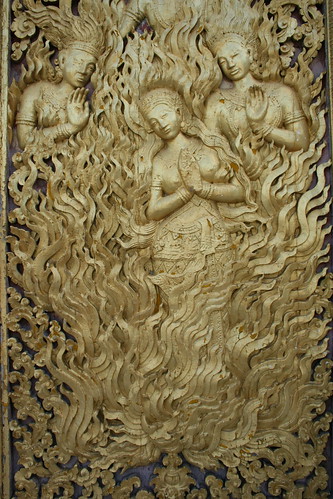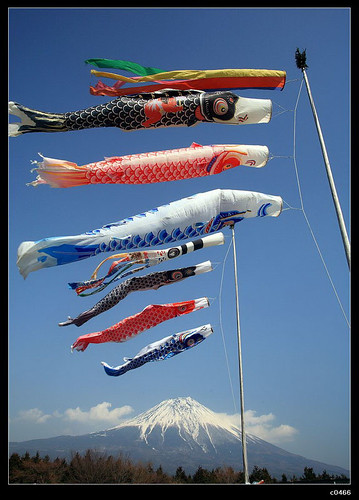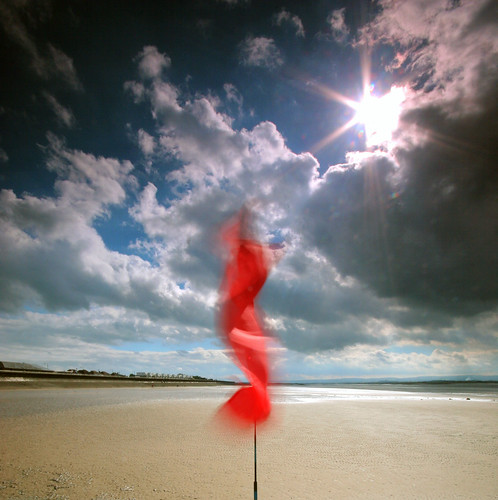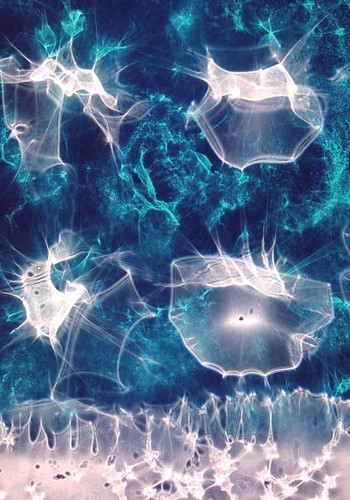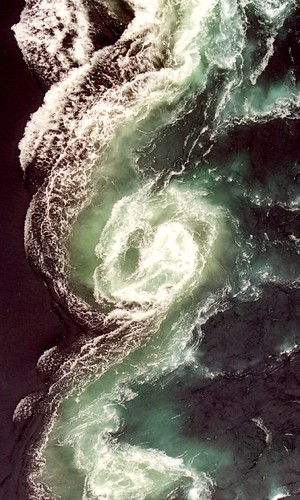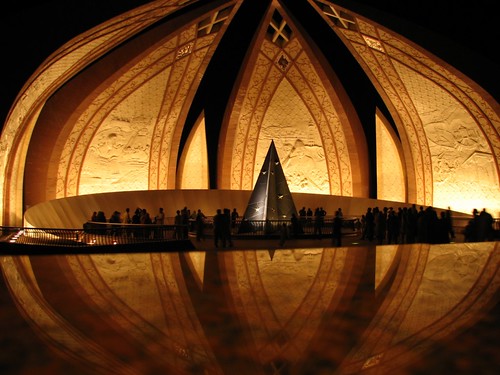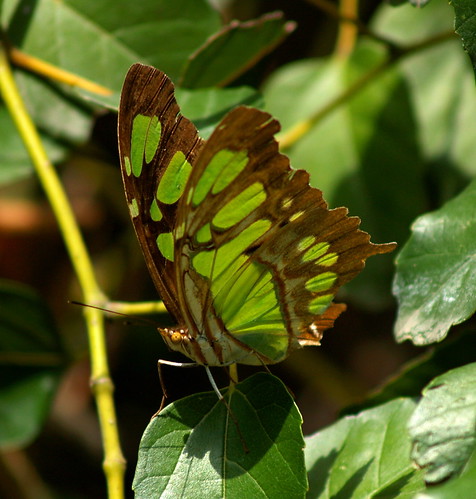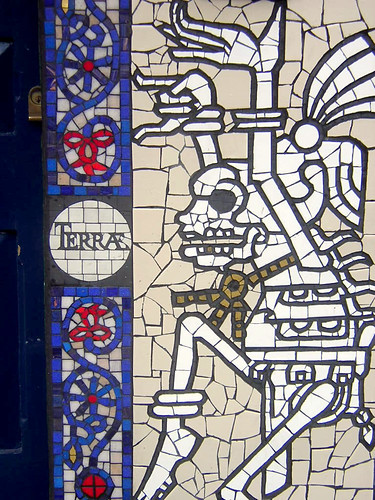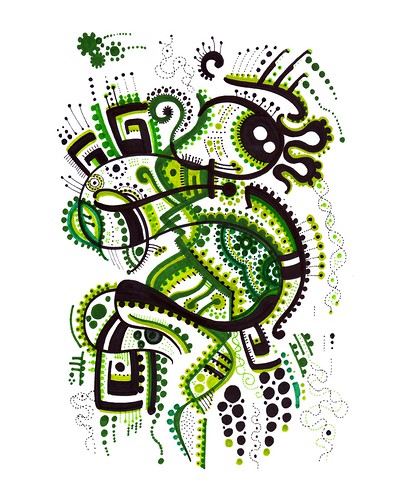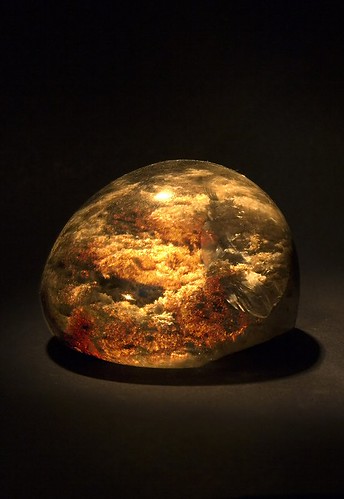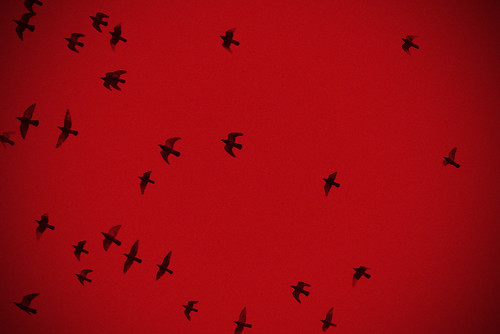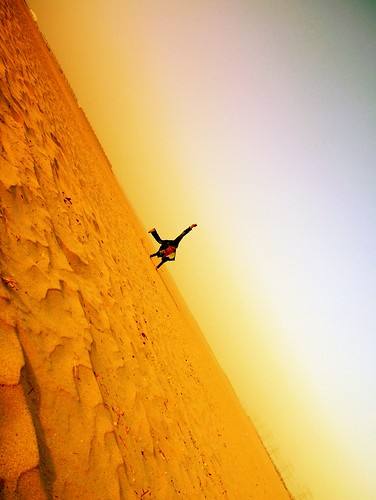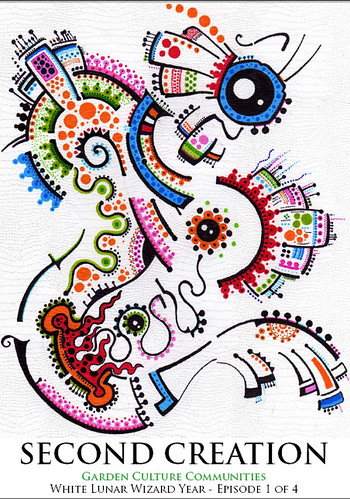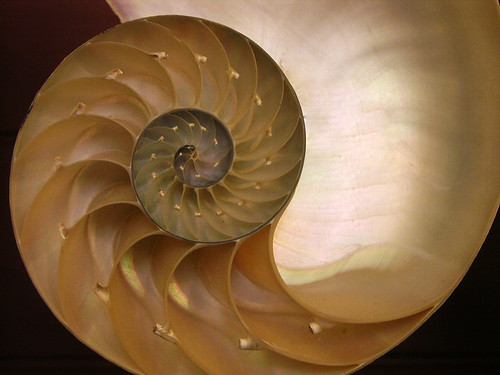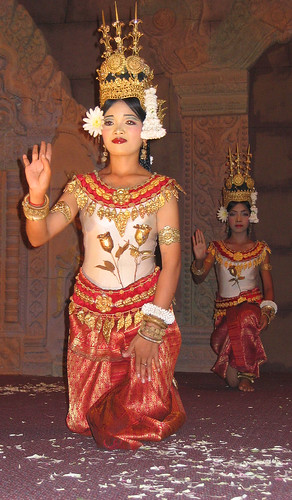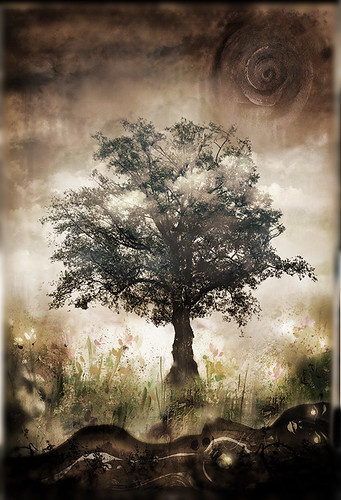By my camera clock, we were at about Launch +16 seconds. I was privileged to meet some family members of the crew before the launch. At this point, the shock wave is hitting us, and my thoughts were for the crew's safety - amidst dumbfounded awe.
I was standing on a grandstand with a thousand or so cheering friends, family, and space-geeks, about 3.5 miles from the launch pad. The sun was beginning to set behind us which gave perfect light for viewing. It was warm and humid, but a breeze was coming at us from across the water. An altogether perfect event.
.
. .
. . .
. . . .
. . . . .
. . . . . .
. . . . .
. . . .
. . .
. .
.
sábado, mayo 31, 2008
JOY RIDE
Carved temple door in Laos.
Laos (pronounced /ˈlɑːoʊs/ or /ˈlaʊs/), officially the Lao People's Democratic Republic, is a landlocked country in southeast Asia, bordered by Burma (Myanmar) and China to the northwest, Vietnam to the east, Cambodia to the south, and Thailand to the west. Laos traces its history to the Kingdom of Lan Xang or Land of a Million Elephants, which existed from the fourteenth to the eighteenth century. After a period as a French protectorate, it gained independence in 1949. A long civil war ended officially when the communist Pathet Lao movement came to power in 1975 but the protesting between factions continued for several years.
Theravada Buddhism is a dominant influence in Lao culture. It is reflected throughout the country from language to the temple and in art, literature, performing arts, etc. Many elements of Lao culture predate Buddhism, however. For example, Laotian music is dominated by its national instrument, the khaen, a type of bamboo pipe that has prehistoric origins. The khaen traditionally accompanied the singer in lam, the dominant style of folk music. Among the various lam styles, the lam saravane is probably the most popular.
The country has two World Heritage Sites: Luang Prabang and Vat Phou. The government is seeking the same status for the Plain of Jars.
The People's Republic of China has recently allowed its citizens to travel more freely to Laos[citation needed]. As such, Chinese tourists are expected to account for 25% of the total number of visitors to Laos (up from only a few percent) in 2006. Pressures to modernize tourist infrastructure, particularly to cater to package tourism, are expected to significantly impact Luang Prabang and other culturally important Laotian cities. The people of Laos have a reputation for being very kind and welcoming to all visitors.
THE FLYING FLAGS
Fuji mountain is very beautiful in Japan, special around the mountain, there are many scenery like cow ranch, flag etc...
Mount Fuji's exceptionally symmetrical cone is a well-known symbol of Japan and it is frequently depicted in art and photographs, as well as visited by sightseers and climbers.
Fuji-san is sometimes referred to as "Fujiyama" in some Western texts, but this reading is not correct in standard Japanese. The often-found or -heard "Mount Fujisan" is redundant since the -san suffix means mountain.
In Nihon-shiki and Kunrei-shiki romanization, the name is transliterated as Huzi. At the Japanese pavilion at the World's Fair of San Francisco in 1939, a gigantic photograph was labeled Mt. Huzi[citation needed]. Nevertheless, the spelling Fuji of the Hepburn romanization is much more common worldwide today.
Other Japanese names for Mt. Fuji, which have become obsolete or poetic, include Fuji-no-Yama (ふじの山, the Mountain of Fuji), Fuji-no-Takane (ふじの高嶺, the High Peak of Fuji), Fuyō-hō (芙蓉峰, the Lotus Peak), and Fugaku (富岳 or 富嶽, the first character of 富士, Fuji, and 岳, mountain).
http://en.wikipedia.org/wiki/Mount_Fuji
THE FLYING FLAGS
RED FLAG DANCING
This flag marking the safe limit of progression along a crumbling slipway at Burnham-On-Sea was being blown around quite vigorously by the strong winds a few weeks ago.
RED FLAG DANCING
viernes, mayo 30, 2008
PRIMAEVAL SOUP
Another 'creation' in the 'Taming Light' set where I try to control or 'coax' the refraction patterns into a little 'scene'. I'm not sure what this looks like to you but the intention was for an 'underwater scene' - not necessarily on this planet although I suppose it could have been at one time.
For new viewers: These are refraction patterns or 'caustics' formed by a light beam passing through shaped and textured plastic forms. For this one, two plastics were used, a coloured one and a clear one in a 35mm film frame size format. The pattern is captured directly on to 35mm film by removing the camera lens and putting the transparent object in its place. Please note these are not computer generated images but a true analog of the way light is refracted by the objects I create.
PRIMAEVAL SOUP
WATER IN A TWIST: SALTSTRAUMEN, NORWAY
Up in the Arctic Circle is the Maelstrom of Saltstraumen. Here (every six hours) you can see the effects of the World's strongest tidal current as 400 million cu.metres of salt water are forced through a 150metre wide channel. Whirlpools up to 10m diam and up to 5m in depth form for about 20mins as the tide flows both in and out of the strait. Large quantities of plankton are brought in followed by fish and attracted by the event are seagulls,fishermen,and tourists. I belong in the last category.
WATER IN A TWIST: SALTSTRAUMEN, NORWAY
PAKISTAN MONUMENT
The National Monument in Islamabad, Pakistan is a national monument representing the four provinces and three territories of Pakistan.
The Monument has been designed to reflect the culture and civilization of the country and also depicts the story of the Pakistan Movement, dedicated to those who sacrificed themselves for future generations. The reddish granite marbel is used in the construction,which is very expensive but the most strong and beautiful stone.
PAKISTAN MONUMENT
miércoles, mayo 28, 2008
COATLICUE
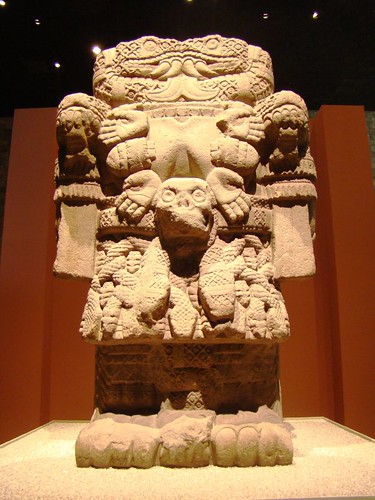
Coatlicue, originalmente cargada por ~*Bomba Rosa*~.
The Coatlicue statue is a 2.7 meter (8.9 ft) tall andesite statue usually identified with the Aztec goddess Coatlicue ("snake-her-skirt"). It is currently located in the National Museum of Anthropology in Mexico City.
On the bottom of the statue, not normally visible, is a carving of Tlaltecuhtli ("earth-lord").
http://en.wikipedia.org/wiki/Coatlicue_statue
COATLICUE
DE LA HOJA AL CENICERO
THE PHILOSOPHER'S STONE
The philosopher's stone (Latin: lapis philosophorum; Greek: chrysopoeia) is a legendary substance, supposedly capable of turning inexpensive metals into gold; it was also sometimes believed to be an elixir of life, useful for rejuvenation and possibly for achieving immortality. For a long time it was the most sought after goal in Western alchemy.
The Latin American spiritual teacher Samael Aun Weor stated that the philosopher's stone is synonymous with the symbol of the stone found in many other spiritual and religious traditions, such as the stone Jacob rests his head upon, the cubic stone of Freemasonry, and the rock upon which Christ lays the foundation of the temple.
| “ | For in Scripture it says: "See, I lay a stone in Zion, a chosen and precious cornerstone, and the one who trusts in him will never be put to shame." Now to you who believe, this stone is precious. But to those who do not believe, "The stone the builders rejected has become the capstone," and, "A stone that causes men to stumble and a rock that makes them fall." They stumble because they disobey the message—which is also what they were destined for. - 1 Peter 2: 6-8 | ” |
He states that this "stone of stumbling" and "rock of offence" is the creative-sexual energy, which in Kabbalah is Yesod ("foundation") that must be transmuted through sexual alchemy. It is said to be rejected by the "builders," meaning those who seek spiritual edification, because they reject the transmutation of sexual energy, and instead use it to achieve sensual pleasure.
http://en.wikipedia.org/wiki/Philosopher%27s_stone
THE PHILOSOPHER'S STONE
lunes, mayo 26, 2008
FREE ENOUGH TO TUMBLE
Now,
I am free.....
Free to live
Free to fly
Free to shape
Free to shine
Free to give
Free to love
Free enough to tumble
FREE ENOUGH TO TUMBLE
viernes, mayo 23, 2008
SECOND CREATION
WULAN AND HER FRIEND
This particular photo was taken during lunch after they finished praying (they were having some kind of celebration.) I didn't ask them to pose for me. They were just having fun and this girl (Wulan's friend, I didn't get her name unfortunately) just hugged her tight and made a squishing sound effect.
I had fun in this place. The people were so nice and welcoming.
WULAN AND HER FRIEND
PERFECT GEOMETRY
Nautilus shell in the British Museum.
“ The wonders of the museum brought here to Bloomsbury from all around the world's imagined corners are numberless. How can they be named? As well tally each leaf of a tree. They come here out of the living minds of generations of men and women now dead – Greek and Assyrian, Aztec and Inuit, Chinese and Indian – who have conceived and carved and hammered and tempered and cast these objects to represent the worlds around them, visible and invisible.”
http://en.wikipedia.org/wiki/British_Museum
PERFECT GEOMETRY
HISTORIA DE UN LETRERO (THE STORY OF A SIGN)
Director : Alonso Alvarez Barreda
Running Time : 04:50
Year : 2007
Country : Mexico/ U.S.A
Category : Short film
...
Currently, Historia de un Letrero is part of the regular programming on National TV in Mexico. Alonso lives in Los Angeles.
HISTORIA DE UN LETRERO (THE STORY OF A SIGN)
AURIN

AURYN is a mystical talisman in The Neverending Story. In the novel, AURYN is always spelled in capital letters and is revered by all Fantasticans as a symbol of its mistress, the Childlike Empress, who is also called “The Golden-Eyed Commander of Wishes” which alludes to her relationship with the AURYN. While the book makes noteworthy point that the image of AURYN is on its "cover(s)", it doesn't actually refer to it as AURYN.
Two mythological serpents, symmetrical, bite at the other’s tails. In the book, they are not specifically or always, intertwined. One serpent is gold and one is silver. Each has an eye to correspond to the color of the book’s print, red and green. The symbol is reminiscent of ouroboros or the mythological Jörmungandr and the Zodiac Pisces. The two snakes represent the dual nature of the two worlds, Fantastica (German: Phantásien) and Reality, but also the twin nature of their mutual creation and destruction. There may also be a relation to the Gates of Horn and Ivory of Virgil's Aeneid. On the back of the AURYN are these words:
"Do what you Wish" (German: "Tu, was du willst").
The AURYN helps guide Atreyu through Fantastica in his quest to find a cure for the ailing Childlike Empress, and in turn defeat the Nothing. It serves him clandestinely, but does return him to the Ivory Tower. Although Atreyu believes himself to have failed in finding the human child past the borders of Fantastica, the Childlike Empress informs him to the contrary and that indeed the boy had been with him all along.
In the hands of the Childlike Empress, the AURYN displays greater powers even in the face of the Nothing. She releases seven spirits to serve her as she ventures across her tattered realm to find the Old Man of Wandering Mountain. They carry her chariot and provide a haven for Atreyu and Falkor within.
Bastian christens the Childlike Empress with her new name. She presents him with AURYN with her only request being that he follows the instructions written on the back. While it grants him the power to make wishes and imagine more of Fantastica, it drains him of his memories which are his only way back to his world. Bastian searches for the same obscure boundaries of Fantastica only to realize it was within AURYN itself.
In the mystical interior of AURYN, two gargantuan serpent statues stand sentry, one shining brighter than white, the other darker than black. They guard the Waters of Life, a waterfall and pool that serve as the exit from Fantastica. The statues refuse Bastian’s passage, for he had left many stories unfinished in Fantastica. Atreyu however agrees to undertake the quest, which allows Bastian to return to his world. When Bastian touches the waters, their truthful properties dissolve the illusion of his glamor wishes, and he returns to being a fat little boy, instead of a Fantastican Prince.
http://en.wikipedia.org/wiki/Auryn#AURYNhttp://en.wikipedia.org/wiki/The_NeverEnding_Story_(film)
AURIN
THE NEVERENDING STORY
Turn around
Look at what you see
In her face
The mirror of your dreams
Make believe I'm everywhere
Hidden in the lines
Written on the pages
Is the answer to our never ending story
ah ah ah
Reach the stars
Fly a fantasy
Dream a dream
And what you see will be
Rhymes that keep their secrets
Will unfold behind the clouds
And there upon a rainbow
Is the answer to our never ending story
ah ah ah
Show no fear
For she may fade away
In your hand
The birth of a new day
Rhymes that keep their secrets
Will unfold behind the clouds
And there upon a rainbow
Is the answer to our Never ending story...
ah ah ah
Never ending story...
ah ah ah
Never ending story.
THE NEVERENDING STORY
martes, mayo 20, 2008
APSARAS
Images of Apsaras are found in several temples of ancient Java dating from the era of the Sailendra dynasty to that of the Majapahit empire. Usually they are not found as decorative motifs but as integral parts of a story in bas-relief, as for example at Borobudur, Mendut, Prambanan, Plaosan, and Penataran. At Borobudur apsaras are depicted as divinely beautiful celestial maidens, pictured either in standing or in flying positions, usually holding lotus blossoms, spreading flower petals, or waving celestial clothes as if they were wings enabling them to fly. The temple of Mendut near Borobudur depicted groups of devatas, divine beings flying in heaven, which included apsaras.
Apsaras represent an important motif in the stone bas-reliefs of the Angkorian temples in Cambodia. Descriptions of the temples often distinguish between two types of depictions of female celestials: depictions of figures who are dancing or are poised to dance, which are called "Apsaras;" and depictions of figures who are standing still, facing forward, in the manner of temple guardians or custodians, which are called "Devatas."
In javanese tradition, apsara describes as the divinely beautiful celestial maidens live in Indra's heaven, and known for their special assingments by Indra to seduce ascetics who may become more powerful than the gods.
http://en.wikipedia.org/wiki/Apsara
APSARAS
LORD HANUMAN

Hanuman is also considered as the incaranation of Shiva or reflection of Shiva. When Ravana tried to enter the Himalayas (the abode of Shiva) Nandi stopped him and Ravana called Nandi a monkey. Nandi in return cursed Ravana: monkeys would help destroy him. In the process word monkey along with panchaksram "Om Namashivaya" hit Shiva. Shiva, to give respect to his devotee, took the form of a vanara, Hanuman.
References to Hanuman in classical literature could be found as early as those of 5th to 1st century BC in Panini's Astadhyayi, Abhiseka Nataka, Pratima Nataka and Raghuvamsa (Kalidasa).
Relation with Shani
In the Hindu faith, Hanuman and Ganesha are two gods not afflicted by Shani. There is also a belief that all the planets are under the control of Hanuman's tail. Whoever worships Hanuman is granted fortitude and strength.
In the Ramayana,Hanuman is said to have rescued Shani, that is, the planet Saturn, from the clutches of Ravana. In gratitude, Shani promised Hanuman that those who prayed to him (Hanuman) would be rescued from the painful effects of Saturn, which in Hindu astrology, is said to produce malefic effects on one's life when one is afflicted "negatively" with Saturn.
Another version of the encounter between Lord Hanuman and Shani Bhagavan is that the latter once climbed on to Lord Hanuman's shoulder, implying that he (Hanuman) was coming under the effects of the influence of Shani. At this, Hanuman assumed a large size, and Shani was caught painfully between Hanuman's shoulders and the ceiling of the room they were in. As the pain was unbearable, Shani requested Hanuman to release him, promising that if a person prayed to Hanuman, he (Shani) would moderate the malefic effects of his influence on that person; following this, Hanuman released Shani.
One more version of the story behind why Lord Shani stays away from those who remember the Lord Ram's name. Once Lord Hanuman was sitting silently absorbed in deep meditation of Lord Rama. Lord Shani passed by and he felt to tease Hanuman. He started teasing Hanuman by pulling his tail, and pinching. Hanuman warned him to go away as he is his Guru's (Lord Sun) son, and so he respects him. When Shani did not hear, then Hanuman started to give him a good thrashing. In the end, Shani pleaded to leave him and Hanuman took a promise from him that Shani will never ever go near a devotee who is meditating on Lord Rama.
There is a spiritual interpretation of the relation between Lord Hanuman and Lord Shani. The former is said to be a symbol of selflessness, while the latter is symbolic of ego and pride. Thus, to counter the karma borne out of selfish action, one must be humble like Lord Hanuman. This is particularly true for those who are said to be experiencing the evil effects of "elnati shani" (in tamil) - a period of about seven and half years when Saturn (Lord Shani) is supposed to afflict the sign in which "planet," the moon is placed in the natal chart of a person.
Sri Panchamukha Anjaneya Swami was the main deity of Sri Raghavendra Swami. The place where he meditated on this five-faced form of Hanuman is now known as Panchamukhi, wherein a temple for him has been built. There is also a shrine for Panchamukha Anjaneya Swami at Kumbakonam in Tamil Nadu, India. A 40 feet (12 m) tall monolithic green granite murti of Sri Panchamukha Hanuman has been installed in Thiruvallur, also in Tamil Nadu. This place was known as Rudravanam in olden times when many saints and seers had blessed this place with their presence. The Panchamukha Hanuman Ashram itself was established by a saint called Venkatesa Battar.
Hanuman assumed this form to kill Mahiravana, a powerful rakshasa black-magician and practitioner of the dark arts during the Ramayana war. Mahiravana had taken Lord Rama and Lakshmana captive, and the only way to kill him was to extinguish five lamps burning in different directions, all at the same instant. Hanuman assumed His Panchamukha form and accomplished the task, thus killing the rakshasa, and freeing Rama and Lakshmana.
This form of Hanuman is very popular, and is also known as Panchamukha Anjaneya and Panchamukhi Anjaneya. (Anjaneya, which means "son of Anjana", is another name of Hanuman).
A 67 foot Murti of Lord Hanuman Ji has been installed at Sankat Mochan Shri Hanuman Mandir, located in the Punjab town of Phillaur.
A 40 foot Murti of Sri Panchamukha Hanuman has been installed at Tiruvallur, near Chennai, India.
A 36 foot Murti of Sri Panchamukha Hanuman has been installed at Panchavatee,Pondicherry, called as Viswaroopa Jayamangala Panchamukha Sri Anjaaneyaswamy.
A 32 foot Murti of Adhivyadihara Sri Bhaktha Anjaneyaswamy,Nanganallur,Chennai which is molded out of a single rock.
Every Face of Sri Panchamukha Hanuman has significance —
- Sri Hanuman faces east. He grants purity of mind and success.
- The Narasimha faces south. He grants victory and fearlessness.
- The west facing Garuda removes black magic and poisons.
- The north facing Varaha, showers prosperity, wealth.
- The Hayagriva mukha faces the Sky. But since we cannot see it, it is usually tilted and shown above Hanuman's face. Hayagriva gives Knowledge and good children.
Presence in the present age
Others have also asserted his presence wherever the Ramayana is read (in Sanskrit, not translated):
यत्र यत्र रघुनाथ कीर्तनम् तत्र तत्र क्रित मस्तक अन्जलिं बष्पावरी परीपूर्ण लोचनम् मारुतिं नमश्च राक्षस अंतकम्।
Which means:
That wherever the deeds of Sri Rama are sung,
At all such places does Hanuman cry tears of devotion and joy,
At all such places does his presence remove the fear of demons.
This can be found in many other texts like Vinaya Patrika by Tulsidas, Mahabharta by Ved Vyasa, Anand Ramayan and many others with slight variation in language/Sentence. Even the places where holy function of Ramayanpath is taking place, there is a special puja and space (or asan) reserved for Hanuman.
http://en.wikipedia.org/wiki/Hanuman
LORD HANUMAN
SHIVA

Shiva is usually worshipped as the Shiva linga. In images, he is generally represented as immersed in deep meditation or dancing the Tandava upon the demon of ignorance in his manifestation of Nataraja, the lord of the dance.
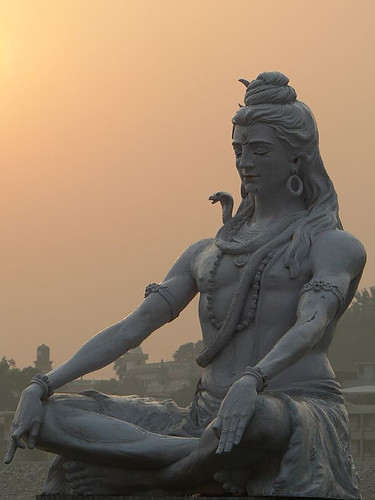
Shiva Gangeses, Rishikesh, originalmente cargada por o_zhdanov.
In South India, five temples of Shiva are held to be particularly important, as being manifestations of him in the five elemental substances:
- Tiruvannamalai, as fire
- Chidambaram, as ether
- Srikalahasti, as air
- Tiruvanaikal, as water
- Conjeeveram, as earth
Lord Shiva also has DashaSahasranamas (10,000 names) that are found in the Mahanyasa.
- Third Eye: Shiva is often depicted with a third eye with which he burned Desire (Kāma) to ashes. There has been controversy regarding the original meaning of Shiva's name Tryambakam (Sanskrit: त्र्यम्बकम्), which occurs in many scriptural sources. In classical Sanskrit the word ambaka denotes "an eye", and in the Mahabharata Shiva is depicted as three-eyed, so this name is sometimes translated as "Having Three Eyes". However, in Vedic Sanskrit the word ambā or ambikā means "mother", and this early meaning of the word is the basis for the translation "Having Three Mothers" that was used by Max Müller and Arthur Macdonell. Since no story is known in which Shiva had three mothers, E. Washburn Hopkins suggested that the name refers not to three mothers, but to three Mother-goddesses who are collectively called the Ambikās. Other related translations have been "having three wives or sisters", or based on the idea that the name actually refers to the oblations given to Rudra, which according to some traditions were shared with the goddess Ambikā.
- Blue Throat: The epithet Nīlakaṇtha (Sanskrit नीलकण्ठ; nīla = blue, kaṇtha = throat) refers to a story in which Shiva drank the poison churned up from the world ocean. (see: Halāhala)
- Crescent Moon: Shiva bears on his head the crescent of the moon. The epithet Chandraśekhara (Sanskrit: चन्द्रशेखर "Having the moon as his crest" - chandra = Moon, śekhara = crest, crown) refers to this feature. The placement of the moon on his head as a standard iconographic feature dates to the period when Rudra rose to prominence and became the major deity Rudra-Shiva. The origin of this linkage may be due to the identification of the moon with Soma, and there is a hymn in the Rig Veda where Soma and Rudra are jointly emplored, and in later literature Soma and Rudra came to be identified with one another, as were Soma and the Moon.
- Matted Hair: Shiva's distinctive hair style is noted in the epithets Jaṭin, "The One with matted hair" and Kapardin, "Endowed with matted hair" or "wearing his hair wound in a braid in a shell-like (kaparda) fashion". A kaparda is a cowrie shell, or a braid of hair in the form of a shell, or more generally hair that is shaggy or curly.
- Sacred Ganga: The Ganga river flows from the matted hair of Shiva. The epithet Gaṅgādhara ("Bearer of the river Gaṅgā") refers to this feature. The Ganga (Ganges), one of the major rivers of the country, is said to have made her abode in Shiva's hair. The legend of Bhagiratha states that when the sage of that name invoked the gods to send the divine Ganges to earth to relieve a drought and purify the remains of his ancestors, he was warned that the earth had not the capacity to withstand the descent of the Ganges from heaven, in pursuit of which he propitiated Siva to receive the Ganges upon her descent from heaven and release her with diminished force. Siva agreed to trap the youthful and mischievous Ganges in his matted locks and release her to the earth. It was thus, according to Hindu legend, that the Ganges came to be trapped in Siva's locks, and to be portrayed as flowing therefrom, in all representations of Siva.[citation needed]
- Ashes: Shiva smears his body with ashes (bhasma). Some forms of Shiva, such as Bhairava, are associated with a very old Indian tradition of cremation-ground asceticism that was practiced by some groups who were outside the fold of brahmanic orthodoxy. These practices associated with cremation grounds are also mentioned in the Pali canon of Theravada Buddhism. One epithet for Shiva is "Inhabitant of the cremation ground" (Sanskrit: śmaśānavāsin, also spelled Shmashanavasin) referring to this connection.
- Tiger skin: He is often shown seated upon a tiger skin, an honour reserved for the most accomplished of Hindu ascetics, the Brahmarishis. Mythology ~ The birth of Brahmarishis (HTML). Retrieved on 2008-05-07.
- Serpents: Shiva is often shown garlanded with a snake.
- Drum: A small drum shaped like an hourglass is known as a damaru (Sanskrit: ḍamaru). This is one of the attributes of Shiva in his famous dancing representation known as Nataraja. A specific hand gesture (mudra) called ḍamaru-hasta (Sanskrit for "ḍamaru-hand") is used to hold the drum.This drum is particularly used as an emblem by members of the Kāpālika sect.
- Nandī, also known as Nandin, is the name of the bull that serves as Shiva's mount (Sanskrit: vāhana).[105][106] Shiva's association with cattle is reflected in his name Paśupati or Pashupati (Sanskrit पशुपति), translated by Sharma as "Lord of cattle" and by Kramrisch as "Lord of Animals", who notes that it is particularly used as an epithet of Rudra.
- Gaṇa : In Hinduism, the Gaṇas (Devanagari: गण) are attendants of Shiva and live in Kailasa. They are often referred to as the Boothaganas, or ghostly hosts, on account of their nature. Generally benign, except when their Lord is transgressed against, they are often invoked to intercede with the Lord on behalf of the devotee. Ganesha was chosen as their leader by Shiva, hence Ganesha's title gaṇa-īśa or gaṇa-pati, "lord of the gaṇas".
- Mount Kailāsa in the Himalayas is his traditional abode.[110] In Hindu mythology, Mount Kailāsa is conceived as resembling a Linga, representing the center of the universe.
- Varanasi (Benares) is considered as the city specially-loved by Shiva, and is one of the holiest places of pilgrimage in India. It is referred to, in religious contexts, as Kashi.
SHIVA
GAIA DREAMING THE TREE OF LIFE
If you believe the idea came first then you must consider weather there is a dimension outside our Universe where the idea came from, a Ur-Universe if you will. If you believe the Universe evolved without the idea then you have to consider that our physical world is forming out of nothing. To put it another way, is the base reality of our world thought or concrete matter? And which came first? Before you answer this question for your self, consider that our human minds are thought not matter. Science can look into how the brain works and see all the ion-gates, synapses and neurons...but we have no idea what patterns are flowiing through this 'machine' and how. The contents of our minds is an abstraction, as software is abstraction inside a computer. So, you could say, we are just thoughts. We are Meta. That makes me wonder if we have more in common with our art than our bodies. More in common with dreams than with reality.
Gaia (pronounced /ˈgeɪə/ or /ˈgaɪə/) ("land" or "earth", from the Ancient Greek Γαîα; also Gaea or Ge (Modern Greek Γῆ) is the primal Greek goddess personifying the Earth.
Gaia is a primordial and chthonic deity in the Ancient Greek pantheon and considered a Mother Goddess or Great Goddess.
Her equivalent in the Roman pantheon was Terra.
http://en.wikipedia.org/wiki/Gaia
GAIA DREAMING THE TREE OF LIFE
lunes, mayo 19, 2008
CUP OF COFFEE?
The English word coffee first came to be used in the early- to mid-1600s, but early forms of the word date to the last decade of the 1500s. It comes from the Italian caffè. The term was introduced to Europe via the Ottoman Turkish kahveh which is in turn derived from the Arabic: قهوة, qahweh. The origin of the Arabic term is uncertain; it is either derived from the name of the Kaffa region in western Ethiopia, where coffee was cultivated, or by a truncation of qahwat al-būnn, meaning "wine of the bean" in Arabic. In Eritrea, "būnn" (also meaning "wine of the bean" in Tigrinya) is used. The Amharic and Afan Oromo name for coffee is bunna.
A coffeehouse in Palestine (1900)
Coffee was initially used for spiritual reasons. At least 1,000 years ago, traders brought coffee across the Red Sea into Arabia (modern day Yemen), where Muslim monks began cultivating the shrub in their gardens. At first, the Arabians made wine from the pulp of the fermented coffee berries. This beverage was known as qishr (kisher in modern usage) and was used during religious ceremonies.[citation needed]
Coffee became the substitute beverage in place of wine in spiritual practices where wine was forbidden. Coffee drinking was briefly prohibited to Muslims as haraam in the early years of the 16th century, but this was quickly overturned. Use in religious rites among the Sufi branch of Islam led to coffee's being put on trial in Mecca, accused of being a heretic substance, and its production and consumption was briefly repressed. It was later prohibited in Ottoman Turkey under an edict by the Sultan Murad IV. Coffee, regarded as a Muslim drink, was prohibited to Ethiopian Orthodox Christians until as late as 1889; it is now considered a national drink of Ethiopia for people of all faiths. Its early association in Europe with rebellious political activities led to its banning in England, among other places.
A contemporary example of coffee prohibition can be found in The Church of Jesus Christ of Latter-day Saints, a religion with over 13 million followers worldwide, which calls for coffee abstinence. The organization claims that it is both physically and spiritually unhealthy to consume coffee. This comes from the Mormon doctrine of health, given in 1833 by Mormon founder Joseph Smith, in a revelation called the Word of Wisdom. It does not identify coffee by name, but includes the statement that "hot drinks are not for the belly", which has been interpreted to forbid both coffee and tea.
http://en.wikipedia.org/wiki/Coffee
CUP OF COFFEE?
LIGHTNING
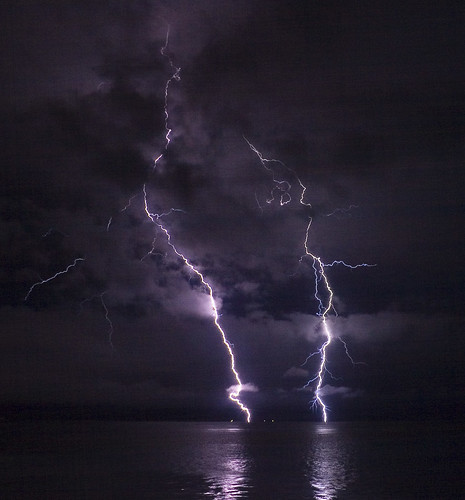
Lightning on the Columbia River, originalmente cargada por phatman.
Lightning is an example of plasma present at Earth's surface.
http://en.wikipedia.org/wiki/Lightning#Extraterrestrial_lightning
LIGHTNING
GOD'S (PLASMA) EYE
In physical and chemical usage, plasma refers to an ionized gas, in which a certain proportion of electrons are free, rather than being bound to an atom or molecule. The ability of the positive and negative charges to move somewhat independently makes the plasma electrically conductive so that it responds strongly to electromagnetic fields. Plasma therefore has properties quite unlike those of solids, liquids or gases and is considered to be a distinct state of matter. Plasma typically takes the form of neutral gas-like clouds (e.g. stars).
Although a plasma is loosely described as an electrically neutral medium of positive and negative particles, a definition can have three criteria:
1. The plasma approximation: Charged particles must be close enough together that each particle influences many nearby charged particles, rather than just interacting with the closest particle (these collective effects are a distinguishing feature of a plasma). The plasma approximation is valid when the number of electrons within the sphere of influence (called the Debye sphere whose radius is the Debye screening length) of a particular particle is large. The average number of particles in the Debye sphere is given by the plasma parameter, "Λ" (the Greek letter Lambda).
2. Bulk interactions: The Debye screening length (defined above) is short compared to the physical size of the plasma. This criterion means that interactions in the bulk of the plasma are more important than those at its edges, where boundary effects may take place.
3. Plasma frequency: The electron plasma frequency (measuring plasma oscillations of the electrons) is large compared to the electron-neutral collision frequency (measuring frequency of collisions between electrons and neutral particles). When this condition is valid, plasmas act to shield charges very rapidly (quasineutrality is another defining property of plasmas).
Lightning is an example of plasma present at Earth's surface.
http://en.wikipedia.org/wiki/Plasma_%28physics%29
GOD'S (PLASMA) EYE
OPHIUCHUS

Ophiuchus (Οφιούχος IPA: /ˌɒfiːˈuːkəs/) is one of the 88 constellations and was also one of the 48 listed by Ptolemy. Ophiuchus was formerly referred to as Serpentarius (/ˌsɚpənˈtɛəriəs/), the former originating in Greek and the latter in Latin, both meaning "serpent-holder". It is a large constellation located around the celestial equator between Aquila, Serpens and Hercules, northwest of the center of the Milky Way. The southern part lies between Scorpius to the west and Sagittarius to the east. Of the 13 zodiacal constellations (constellations that contain the Sun during the course of the year), Ophiuchus is the only one not counted as an astrological sign.
It is best visible in the northern summer and located opposite Orion in the sky. Ophiuchus is depicted as a man grasping a serpent; the interposition of his body divides the snake constellation Serpens into two parts, Serpens Caput and Serpens Cauda, which are nonetheless counted as one constellation.
The brightest stars in Ophiuchus include α Ophiuchi, called Rasalhague (at the figure's head), and η Ophiuchi.
Barnard's Star, one of the nearest stars to the Solar System (the only stars closer are the Alpha Centauri binary system and Proxima Centauri), lies in Ophiuchus. (It is located to the left of β and just north of the V-shaped group of stars in an area that was once occupied by the now-obsolete constellation of Taurus Poniatovii, Poniatowski's Bull.)
In April 2007, astronomers announced that the Swedish-built Odin satellite had made the first detection of clouds of molecular oxygen in space, following observations in the constellation Ophiuchus.
This amazing complex of nebulosity revealed on long exposure color photographs is one of the most beautiful areas of the entire night sky.
It contains dark nebulae where lanes of obscuring dust hide background stars, blue reflection nebulae where the dust is illuminated by nearby stars and red emission nebulae where the hot hydrogen gas itself is glowing.
Also visible is a rare orange/yellow reflection nebula around the red-giant star Antares which is the overexposed object just to the left and slightly below the center of the photo.
Globular cluster M4 is just to the right. Rho Ophiuchi is the triple-star surrounded by IC 4604, the large blue reflection nebula at the top of the photo. Emission nebula Sh2-9 is at right.
Serpentarius
Teniendo en cuenta que no existe ningún organismo regulador de ésta, hay casi tantas interpretaciones al respecto como astrólogos. Al tratarse de una creencia muy antigua, sus reglas no contemplan los cambios que ha sufrido la astronomía a lo largo del tiempo, como el descubrimiento de los planetas exteriores del Sistema Solar (Urano, Neptuno y Plutón), la precesión, los nuevos objetos (cúmulos, púlsares, quásares, etc.), o los supuestos nuevos signos como Ofiuco y Ballena.
http://en.wikipedia.org/wiki/Ophiuchus
OPHIUCHUS




